Menus
- 4-stroke single cylinder, 445 cm3, 34 hp at 7000 rpm, 36 N.m at 5500 rpm, 148 kilos dry, € 5,490
- A nice and versatile neo retro roadster
- Discovery
- In the saddle
- In the city
- On motorways and main roads
- On departmental
- Cycle part
- Brakes
- Comfort and duo
- Consumption and autonomy
- Conclusion
4-stroke single cylinder, 445 cm3, 34 hp at 7000 rpm, 36 N.m at 5500 rpm, 148 kilos dry, € 5,490
A nice and versatile neo retro roadster
Is it the return in force of the average displacement? We will see the transformation of the market that the A2 license will generate for all, but it is clear that the offer from manufacturers is diversifying at high speed, the last EICMA show in Milan having unveiled a plethora of machines between 250 and 410 cm3. This to be added to the players present on the market, such as Royal Enfield, Mash and SWM.
SWM, therefore. The Italian brand made its comeback last year with a rather nice range of single cylinders in tune with the times. There are three of them: the Gran Turismo, our test model, the Silver Vase, Scrambler style and the Gran Milano, cafe racer style, but still much more advanced in terms of braking and suspensions. SWM puts its cards on the table and admits having gone to China to market. We see some of them wink and immediately think of Mash. It is true that China is a veritable motorcycle supermarket and that you can easily do your shopping there and then organize the assembly according to these wishes. However, SWM has a slightly different approach: if the mono comes from Shineray, just like that of the Mash 400 Adventure recently tested on the Den, SWM has chosen a singular mechanical variation (double exhaust, oil cooler, injection … .) and the motorbikes are assembled in Italy, in Varese, in the old Husqvarna factories.
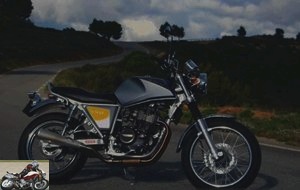
However, you must no longer be young and have had an appetite for off-roading to keep a memory of the rich hours of SWM. Italian as its name suggests (Speedy Working Motors! But note, for the anecdote, that the initial plan was SVVM, for Sironi and Vergani, the two creators of the brand, Vimercate, the name of the village in the suburbs of Milan and Motori, which we won’t insult you to translate), the brand initially lived from 1971 to 1984 with the objective of creating the best off-road, cross-country, enduro and trial machines. With a world title obtained in 1981, we can say that they did not totally miss their goal. Today, the brand has been taken over by Ampelio Macchi, former technical director at Aprilia and Husqvarna, as well as Daxing Gong, a Chinese businessman involved in the Shineray group. If SWM retains a TT and SM range (overall, old rebadged Husqvarna), the family of 3 single cylinders to which our Gran Turismo belongs is certainly generating higher sales figures. There remains the unknown of the prestige of the SWM coat of arms in the eyes of customers, but when we see that brands that came out of nowhere have succeeded in establishing themselves, is it so important ?
Discovery
Available in blue or gray, the SWM 440 Gran Turismo is perfectly in tune with the current trend which emphasizes retro. Not aping any known reference, it has its own identity and arises as an archetype of classicism with its fork gaiters, wire wheels, chrome front fender as well as double rear shock absorbers and exhaust mufflers. The most unique design element is certainly its angular tank; Either way, the 2016 SWM Gran Turismo does not deserve in a rally of ’70s motorcycles and that is certainly the intended purpose..
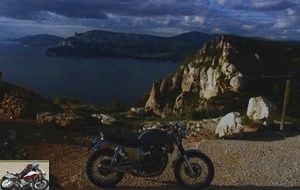
Approaching, we see that the finish is overall very good, with rather neat assemblies, a quality satin paint, wheels and front mudguards that do not mess, a beautiful integration of the injection box. Nibbling a bit, the dashboard mounting bracket is a bit low-end 125 and the levers are not adjustable. But for the rest, here is a pretty little motorcycle that we will enjoy contemplating and showing off…
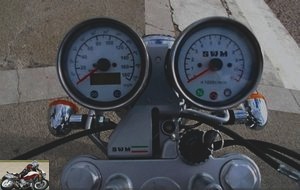
In the saddle
A small mono of 148 kilos dry, here is a motorcycle which casts wider than an electoral program! It is true that the Gran Turismo wants to be accessible from all points of view and that it puts all the assets on its side to achieve it. Admittedly, the saddle is perched at 820mm, but the Gran Turismo is thin, petite and compact, which makes it really easy to handle. Only downside (for some): the levers, on the other hand, are not adjustable.

The riding position is quite natural, with a flat handlebar and not curved. It is impossible not to realize, once again, the architectural specificity of the reservoir. Admittedly, its forms refer to features of historical designs at SWM; nevertheless, its edges are protruding and depending on the morphologies, you will have the knees which fit well in the folds, or not. And rather not, in fact. That said, riding with the legs apart optimizes the cooling of central physiognomic elements..
For starting, no starter, thanks to the injection. We are faced with a fairly basic dashboard as a whole, with two large blocks dedicated to the speedometer and the tachometer and we are not overwhelmed by information! The digital window just leaves the choice between the totalizer and a single trip, but we still find a fuel indicator. The set, however, is not very qualitative with a somewhat cheap mounting plate, despite the presence of the SWM logo and the Italian flag. The tachometer has a red zone that starts at 10,000 rpm. Um, wouldn’t that be a little optimistic ?

In the city
A single cylinder is not intended to be flexible at low speed (the Royal Enfield being, among all its qualities, a delicious exception!) And we remember that during the test of the Mash 400 Adventure, the mono 400 made in Shineray hadn’t left a strong impression of his lack of docility. But there, the mono is more frequent, for two reasons: it is a little more flexible and round in its operation, thanks to the injection chosen by Speedy Working Motors and the final gear ratio is a bit shorter. Result, at 50 km / h, we are at a puillème above 3000 rpm and the mono turns smoothly.
For the rest, it’s happiness: a reduced weight and a contained template facilitate urban evolutions and the braking is really adjustable (more on this later …).
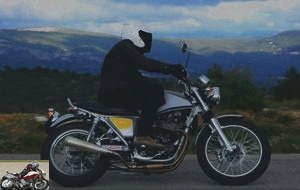
The turning radius is quite good (you can do U-turns on a departmental without dismounting, even if in this area, a Royal Enfield does even better) and the sound is typical mono, nice but rather discreet. What to have fun without pissing off the neighbors.
On motorways and main roads
With 34 horses, we suspect that despite its name, the Gran Turismo has its own interpretation of grand touring. But then again, the SWM scores points and displays its difference from other machines powered by similar engines. Because, taking once again, the Mash 400 Adventure as a reference base, the single-cylinder 440 of the SWM has many other qualities: softer at the bottom, rounder in the middle, it lengthens the stride more while having resources. up to 8000 rpm (instead of 7000) while showing much less vibrancy over the entire rev range. Suddenly, the 445 cm3 engine of the SWM is much more pleasant to use in all cases..
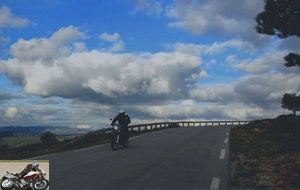
Tested for you (on private roads, as required by the legal notice), the maximum speed comes out at 150 km / h counter at 8000 rpm, while the speed drops to 7000 rpm at 130 km / h. For the longevity of the mechanics, we will therefore avoid major motorway routes, but a one-off excursion on a 4-lane will be without suffering. Although: not tested long enough to make a definitive judgment, the saddle still seemed potentially firm on long journeys. Stability side: RAS.
On departmental
This is the ideal playground for all motorcycles and the SWM 440 Gran Turismo is no exception to the rule. At 90 km / h, the small mono turns at a little over 4,500 rpm and its pickup capacities are quite correct, the maximum torque of 36 N.m being delivered just after, at 5,500 rpm. the big advantage of a well-bred small mono is its ability to provide pleasure without reaching supersonic speeds, which makes it possible to be a good citizen !
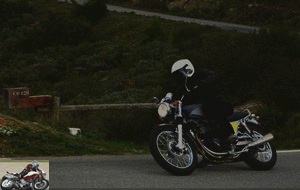
In this environment, the SWM 440 Gran Turismo proves to be widely frequented: its chassis is healthy, its technical solutions proven and it lets itself be taken into bends with great ease and neutrality. This has two advantages: it is accessible to all and will be able to deliver pleasure to a somewhat experienced biker.
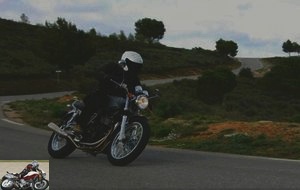
Cycle part
Here again, the Gran Turismo aligns classic solutions. The suspensions are signed Fast Ace, a Chinese manufacturer which we have already spoken about during the test of the Mash 400 Adventure. Double rear shock absorber (adjustable preload, 99mm travel) and conventional front fork (43mm diameter, 130mm travel). What matters is that the suspensions do their job properly and they are. No untimely racket hits from the rebound dampers, fairly regular compression in front, all is well and it is perfectly consistent with this level of range. More demanding users will eventually look at the Gran Milano, which offers an inverted fork..
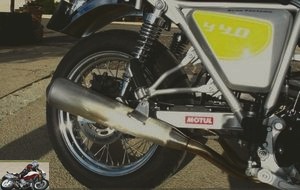
The tire fitting is entrusted to modest dimensions (100/90 x 19 front, 130/80 x 17 behind) and the tires are Michelin Pilot Activ, which can reassure buyers who are not confident about the exotic tires often mounted on the machines. who are. Quite stingy with information feedback, however, they did not pose any grip problems. Even the few bends taken at high speed and their mileage longevity are part of their recognized qualities. They keep inner tubes.
Brakes
Double disc in the program, which will make it possible to pass Euro 4 (very) soon thanks to the addition of an ABS central. Progressive and controllable, the brakes (whose disc offers a diameter of 260mm in front and 220mm behind) will be perfect for beginners, but experienced riders will likely find that the front is a bit tight on both bite and kick. power, in particular because the accuracy of the chassis encourages a high pace as soon as bends arise.
That said, cousin Gran Milano offers a Brembo radial caliper; and since we are talking about it, the price difference – 500 € – is reasonable given the upgrade in terms of brakes and suspensions, which means that it is this version that is needed advise the most demanding pilots.
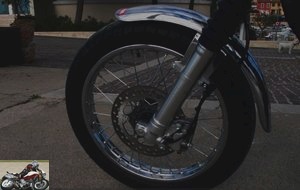
Comfort and duo
We didn’t ride long enough in one go to be able to give a definitive opinion on long-haul comfort, but the saddle already felt a bit firm on short stages. To be checked, then. However, the Gran Turismo has the merit of offering an engine that vibrates little and rather decent suspensions. The protruding shapes of the reservoir may, however, irritate a little over time. The passenger has a nice grab handle. Nothing therefore stands in the way of sharing the joys of SWM as a couple.
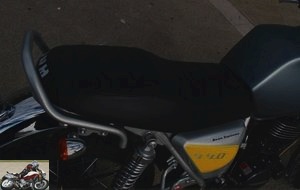
Consumption and autonomy
Here too, we were not able to measure real consumption over a long distance. From experience, we know that this type of engine is generally held in a range of 3.5 to 4.5 l / 100. With the 22.5-liter tank, that’s 500 kilometers of guaranteed autonomy, as well as fairly low running costs. The tank is locked, but the cover is not hinged.
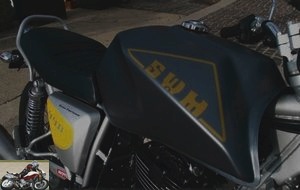
Conclusion
For € 5,490 (until December 31, 2016, after which the price will rise to € 5,690), the SWM 440 Gran Turismo offers a rather enticing neo-retro allure, a completely correct build quality and services that will suffice for beginners. where to those who see the virtues in simplicity, in particular because this one encourages to rediscover the secondary network. What we will also remember is its mechanical approval, clearly superior to equivalent engines of the same origin, the improvements desired by SWM having borne fruit..
In fact, the SWM 440 Gran Turismo refers to the quintessence of the spirit of the motorcycle: two wheels, an engine, a nice little line and basta! For a price barely higher than 5,000 €, it promises kilometers of pleasure for beginners as well as experienced bikers who value simplicity. And it shows that components made in China can be very frequent in use..
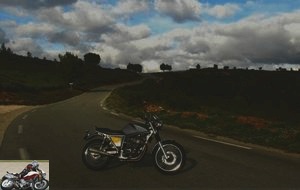
Strong points
- Nice look
- Nice engine
- Easy to learn for beginners
- All the joys of a simple motorcycle !
- Healthy frame
- Consumption / autonomy
- Interesting purchase and use cost
Weak points
- Tank ergonomics
- Shy front brake
- Some finishing details
- Saddle a little firm ?
SWM 440 Gran Turismo technical sheet
Test conditions
- Itinerary: a short day trip in Provence, around Marseille and on the Route des Crêtes.
- Motorcycle mileage: 500 km
- Problem encountered: none
Related articles
-
Test MV Agusta Turismo Veloce 800 Lusso SCS
A very high-end and very techno vision of fast tourism 3 cylinders in line, 798 cm3, 110 hp at 10,150 rpm, 80 Nm at 7100 rpm, 192 kilos, € 21,490 Be…
-
Test MV Agusta Turismo Veloce 800
The TGV (High Speed Tourism) according to MV Agusta A motorcycle completely redesigned for tourism and equipped with real saddlebags. MV Agusta…
-
Kawasaki Z H2 Supercharged motorcycle test
200 hp, 14 mkg at 8,500 rpm, 239 kg all full, 17,099 € Put some salt ! Fifteen days of driving with the Kawasaki Z H2? I say it bluntly, it takes less to…
-
Baby GS: the Trail is back Paradox. It is by imposing its flat on the Paris Dakar, that BMW has shifted the market from mono to twin, causing the…
-
Triumph Sprint GT motorcycle test
Mister Hyde in velvet panties !! 3500 km test Triumph unveiled the Sprint GT in 2010, evolving into a more road version of the ST. Seen from the front,…
-
Royal Enfield Meteor 350 motorcycle test
Entry-level, extra class Air / oil single cylinder, 349 cm3, 20 hp and 27 Nm, 191 kg full made, from 4.099 euros Royal Enfield commemorates its 120th…
-
Moto Guzzi V7 III Carbon, Milano & Rough test
A neo-retro range which now goes to 6 models V2, 744 cm3, 52 hp at 6200 rpm, 60 Nm at 4900 rpm, 193 kilos dry, from € 8,999 Please note: we are not here…
-
The R 1200 R sees Red Continuing to expand its range, BMW is offering its new water engine in a road roadster which abandons the iconic Telelever front…
-
Harley Davidson Ultra Classic and Ultra limited Rushmore test
Harley Davidson takes the plunge (and us with)! In the increasingly competitive world of luxury GTs, Harley Davidson is redesigning its copy and…
-
A small roadster with a neo sport cafe look for A2 licenses … and others Single cylinder, 286 cm3, 31.4 hp at 8,500 rpm, 27.5 Nm at 7,500 rpm, 143…
Objectively, it is almost the "ideal" wheel for a relatively young audience or those who like fun motorcycles..
Aesthetically, I find this new style successful. But I have more trouble with the visual finishes on the engine / frame level: too many small spaces, "disparate" elements at this level.
And then I find that his price has increased too much. This should be worth 6,800 for example (with an anti-dribble …) and a SP version with adjustable inverted fork and more capable shock absorber would be 7,999.
Our next Trident / MT / CB R comparison is going to be interesting …
16 kg frame, 54 kg engine all for 74hp and 184 kg tpf…
it’s heavy, and rather expensive for the equipment it presents.
no hydraulic or anti dribble clutch, no efficient or adjustable abs, always these famous suspesion that would shame some 50cc
and the chassis must be autemps "imprecis" (it is not bad for autemps) than the old one.
I would like on the other hand to know the weight of the scaffold to know how many kg of cast iron Yamaha had to add to it for past the euro 5 standards, are aspec gross do not bother me since it is in order to reduce its price manufacturing to avoid skyrocketing the selling price.
I find it more beautiful than the old one, but not more interesting or fun (in addition it catches up to the selling price of the late Duke 690, which was hardly more expensive but much more equipped, and with quality)
Price modified in the article
We will still tick a little on the telescopic fork or on the finish which seems to me still a little below the Yamaha standards, which are already quite low in general but hey, we remain on a contained price for an efficient and widely acclaimed machine. by the public AND the press.
I tried the first version
And I opted for the mt.03 320 cc
In 2016 (while I have my A license since 1969) which I preferred for its suspensions, its lightness, (15 kg less) its power-to-weight ratio, etc. ..
And I transplanted to the thing in 2019!
I will change soon but it will not be for a Mt.07. It does not represent an evolution but only an alternative..
The real difference will be with a KTM 890r or an Aprilia 660 …
It is exactly that. Beautiful philosophy
Oueps! It’s certain ! it’s not worth fighting red !
It seems to me, more or less, that its power is equivalent to the 72 or 74 CV, better chais, of my ex SV650S of 1999. Which had only 645 cc, but more noble engine, in V at 90 °. On the other hand, it was undeniably heavier, with a full weight that must have turned around maybe 205 kg? Chais could well there either … A force to drink! 😅
In short ! She moves me one without shaking the other! Never disappointed that the golden age of Yam 2T is over! Including the 350 RDLC 4LO, well NAN! tense ! But that life has become very monotonous … I have to adjust my hearing aid !

Wouldn’t have one, two or three tuning forks … Worthy of the name ?
Great article beautifully written by a Damien Bertrand inspired as always. The best and most reliable motorcycle journalist on the market.
This test of the Yamaha MT 07 is complete and we know what to expect at the end. So much so that I plan to buy this model, after having tried it all the same as well as the Triumpf Trident but of which I like less the neo-retro side which will be quickly out of fashion in my opinion..
Thank you The Den for all the work you do!
Yes, "This concrete gray", horrible, like the lighthouse that you would have to try on a moonless night … I remember having tried a bum, a few years ago, I will go try this one to see if Yam found the procedure to make a real saddle … But given the unworthy passenger jump seat, I have a big doubt …
Little mistake in the article "in 180/55 front and 120/70 in the back."
The YZR 500 OWD3 in anniversary with the same stats 160hp 130kg…
Oh dear
That’s what we want: less powerful but light motorcycles instead of heavy monsters.
It is better 100 hp for 160 kg than 170 hp for 210 kg.
From 1984 to 1989 Suzuki marketed around 1,500 units the RG 500 Gamma, a 4-cylinder 2T square (!) That made 95 HP for 154 kg dry … and 230 km / h. A racing animal on the road.
Really not a handle this Wyn. These modifications really have a crazy finish. Frame dubbing was common among preparers ?
For the mountain bike anecdote, the world record is the young Frenchman Eric Baronne who holds it on snow at 227km / h, in Vars it seems to me. He tried once on the land of a volcano, but it went wrong …
Of these, the majority were steel-frame motorcycles producing 87 horsepower at 9,500 rpm (78 hp at the rear wheel) for European markets…..
Strange because an RG500 comes out stock 75hp at the wheel and forgets the RDLC…
which is actually 10 less, or if I count 65hp,
and not these 78hp.
In 2000 and 2001, the TDM was still at 850 (4TX model)
The 900 (5PS model) did not appear until 2002.
The fuel gauge does not have 8 batons, but 6…
The temperature on the right of the dashboard is not that of the oil, but that of the coolant…
The lights do not come on automatically (and that’s good)…
"The whole thing gives the impression of a bicycle": the center of gravity is still rather high, but it is true that once you get used to it, it swings well.
“You can really feel the twin cylinder, which hits easily below 3,000 rpm. ": Known problem, just disconnect wire n ° 8 from the ECU to remove the breathing stupidity through a different conduit under 4000 revolutions.
On the 2002 and 2003 models, we will also change the ECU…
“Finally, when I say all at once, with a 5-minute petrol break after 200 km. »: With 20 L in the can and a consumption of 5 to 6 L / 100, the range can reach 400 km.
“The TDM illuminates correctly in low beam, nothing more. As for the high beams, they bring little additional power, despite an impressive frontal optics. It is therefore essential to slow down. ": It’s not wrong, that’s why for 50 euros, I mounted additional LED lights from alibaba, it’s Versailles !!
The must read of the owner of TDM is the site "Inside the TDM" of JBX, readable in French and in English.
hello, pocessor of a YAMAHA TDM 900 from 2002 (the 1st … a little guinea pig)
I throw a bottle into the sea…
the author of the above comment (as of March 22, 2019)
mentions the fact that it "suffices to disconnect wire number 8 from the ECU" to solve the low speed injection problem of this TDM 900
If a charitable soul would enlighten me, I would be grateful to him 🙂
firas06@hotmail.fr
@ FI06: no need to leave an email, the light shouldn’t take too long to shine on you here.
Moreover the questions are rather to be asked in the section "www.tdm-yamaha.heliohost.org] ?